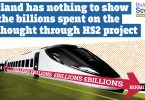 Two major events happened in the UK energy market last week – the first was extremely well publicised and dominated the news cycle for 48 hours the second went by barely noticed.
Two major events happened in the UK energy market last week – the first was extremely well publicised and dominated the news cycle for 48 hours the second went by barely noticed.
I’m talking respectively about the announcement of a new nuclear power station at Hinkley Point in Somerset and the launch of the prototype of the world’s largest offshore wind turbine at the Fife Energy Centre in Methil.
Now offshore wind and nuclear power have more in common than you think. They are both prohibitively expensive. They both require public subsidy. And they are both unlikely to meet our current energy needs in the immediate future.
But they are the only available choices when we talk about long term, large scale, non-carbon energy generation.
A choice between two futures
Hinkley C is due to come online in 2023 with a capacity of 3.2 gigawatt with other nuclear power plants proposed. Offshore wind is scheduled to be online with a capacity of between 10 and 20 gigawatt in the same time frame.
Taking into account the differing natures of how they generate their power, nuclear and offshore wind they are broadly comparable in size and effect and both will make significant steps towards decarbonising our energy mix.
However, given the level of public subsidy required for either, it is unlikely that any government in Scotland or London would choose to do both. Given the choice we are clear that in Scotland at a government level and across the wider community we are for renewables and against nuclear.
Economic strengths of renewables
That consensus is not just a political or environmental one. There is also a strong economic argument which relates to our strengths as a country and finding that niche market which exploits those strengths. Most analysts will argue that not only does Scotland have the required inputs to make renewables work – wind, water, tide – it has the engineering expertise to apply them.
Whilst new nuclear may provide a short term construction boost it leaves no medium to long term engineering or operational legacy. For a country like Scotland with nearly fifty years experience in an offshore environment, the prospect of going renewable offshore has far greater potential than going nuclear onshore.
But the decision to go for new nuclear in the UK is in danger of making the decision for us about renewables in Scotland, because the subsidy required to build and operate new nuclear is drawn from the same pot as the subsidy required to build and operate offshore renewables. It must also be noted how prohibitively expensive nuclear decommissioning can be. One estimate for Sellafield nuclear plant was £67.5 billion.
This switch of subsidy from one source of energy generation to another doesn’t just use up subsidy which we could use elsewhere in the long term, it saps investor confidence in the here and now.
Westminster causing uncertainty when Scotland needs control
 Businesses looking to invest in offshore renewables need to know that there is a future market for their product. If the UK subsidy switches from renewables to nuclear it threatens current R&D which may in turn switch off future investment.
Businesses looking to invest in offshore renewables need to know that there is a future market for their product. If the UK subsidy switches from renewables to nuclear it threatens current R&D which may in turn switch off future investment.
So whilst the Scottish government may want to continue to invest in offshore renewables their partners in industry may take a hard look at UK policy and decide against it.
Clearly I’m a renewable enthusiast and a nuclear sceptic, but the point from a business perspective is not whether one answer or another is correct. The point is certainty and control – certainty about future decision making and control over all of the levers which effect those decisions.
The Hinkley Point decision has very serious repercussions for Scotland yet we have no say over that decision. It will draw from budgets we have already committed for other projects, yet we have no say over how those budgets are spent. It brings uncertainty to a market the Scottish government and Scotland have prioritised, yet we lack the powers to bring the certainty required.
Conclusion
Uncertainty and lack of control kills confidence in any business arena. To end the uncertainty and get control we need decisions about our energy mix and the subsidies we choose to decarbonise that energy mix to be made in Scotland.
And the only way to do that is a yes vote next September.
– Gordon Archer
Economic facts on renewables in Scotland:
1) Over 11,000 people are employed in renewable energy in Scotland as of March 2012.
2) Renewable energy production in Scotland is at a record high, accounting for 14,600 gigawatt hours in 2012.
3) Whitelee windfarm, in Eaglesham Moor, East Renfrewshire, is the second biggest onshore windfarm in Europe. According to Siemens, global demand could quadruple by 2030.
4) The Pentland Firth is the best site for tidal power in the world.
5) Scotland has 25% of Europe‘s total tidal and wind potential.
Join Business for Scotland – Read More








Gordon, we may have the potential, but we lack the infrastructure to exploit it. To collect the 10GW or so of onshore windpower capacity that could be built, we’d need to cover the highlands with 132, 275 and 400kV transmission lines. And after the fiasco of the Beauly-Denny public inquiry I don’t see any investor-owned transmission company taking on that risk.
As for nuclear, might I point out that when HunterstonB is closed down, we’ll have no conventional generation south of Cruachan or west of Torness. The whole burden of controlling Scottish system voltage and frequency will fall on Peterhead and the scattering of small hydro. That means that whenever a high pressure cell sits over central Scotland in winter (high demand, low temperatures, negligible wind production) we’ll struggle to generate (or import) enough power to keep the lights on in Glasgow and surrounding area. That’s a lot of customers shivering by candlelight.
And don’t get started on the economic burden of having to underwrite the ‘green’ subsidies paid to Scottish-sited renewables (England may not need to import our green power). 100% renewables>? don’t make me laugh.
The gov. .In England the need for nuclear power is needed to sustain the energy requirements of 50 million + people.
The Scots have the rain fall and geography to generate vast amounts of hydro power.easily enough to meet the needs of 5 million, with out wind or any extractive processes.The mighty Loch Sloy lies idle most of the time.Why ?
Torness has had two emergency shut downs this month.E.D.F.will be economical with the truth as usual.Like the cracked graphite bricks at Hunter stone B which is going to be run to destruction.The British and others have
pioneered the development of tactical nuclear battle field weapons.Depleted uranium a word that can mean any cocktail of isotopes.And its a great way
to get rid of nuclear waste .A nuclear power plant is needed to enrich uranium
for Trident.A power plant doesn’t run on
enriched stuff.The next generation of Trident will be three times as powerful
as today’s. Cesium isotopes have shown up in Dalgety bay. Now we know for sure
Its all been coming from the nuclear submarine scrapyard at Rosthy.Watch the
M.O.D.lie again.Why arent Sepa all over this.Have they been nobbled by the MO.D.
and the O.S.A. It’s in our own best interests to bale, before our whole coast line becomes a no go zone.
“Hinkley C is due to come online in 2023”
More like 2320.
[…] Two major events happened in the UK energy market last week – the first was extremely well publicised and dominated the news cycle for 48 hours the second went by barely noticed. […]
‘Whitelee’ On land ‘belonging’ to whom? Since when? Previous and current occupation/s of owner/s?
[…] Independence will deliver a sustainable future […]
“4) The Pentland Firth is the best site for tidal power in the world.”
Except for the Bay of Funday
Or Ushant? [Where i sat out tail sans sail but motor on agin the storm that dis-masted Heath’s yacht in harbour whilst other 2 of 3 crew slept-off exhaustion. Surfed into Brest later when things had calmed down.]
But yes, west coast tidal races should be in the energy mixed source equation, as higher volume, slower speed estuaries too.z